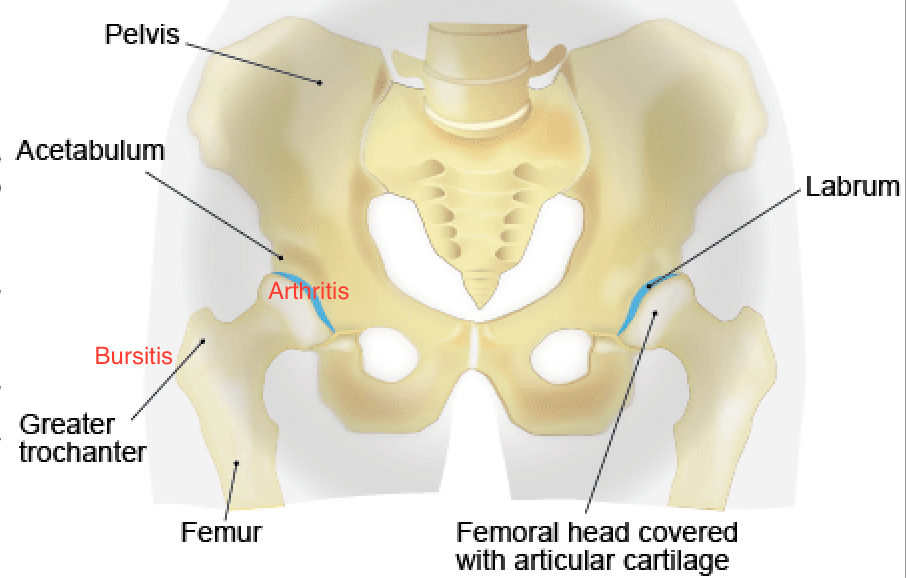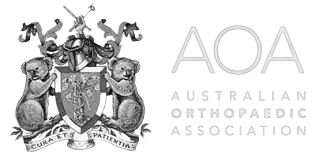Hip and Groin Pain
What is Hip and Groin Pain?
Hip and groin pain is any discomfort or pain felt in the hip joint or groin area.
The hip joint is the largest joint in the body and supports the body's weight during movement. The groin area, on the other hand, is the region where the abdomen meets the thigh.
Pain felt inside the hip joint or your groin area is more likely because of the problems within the hip joint. Likewise, the pain felt on the outer side of your hip, upper thigh or buttocks may result from the problems of the muscles, ligaments, tendons and soft tissues ,incuding bursitis surrounding the hip joint.
However, certain disease conditions affecting other parts of your body, such as the lower back also may cause hip pain.
How Does Hip and Groin Pain Impact Your Anatomy and Health?
Pain in the hip and groin can lead to reduced mobility, affecting daily activities such as walking, sitting, and even sleeping. This pain can also affect other areas of the body, such as the lower back, knees, and ankles. Moreover, chronic hip and groin pain can lead to depression, anxiety, and a decreased quality of life.
Who is Most at Risk for Hip and Groin Pain?
Hip and groin pain can affect anyone, but some people are more at risk than others. Athletes who participate in activities that involve twisting, jumping, and sudden changes in direction are more likely to experience hip and groin pain. Additionally, people with a family history of hip problems, such as hip dysplasia, are at a higher risk.
Causes of Hip and Groin Pain
The main cause of sudden pain in the hip is an injury resulting in a fracture of the hip bone. Hip fractures are common in elderly individuals because the bones wear out as age advances. Other causes include:
- Osteoarthritis
- Rheumatoid Arthritis
- Labral Tear
- Hip Fracture
- Bursitis
- Tendinitis
- Hip Flexor Strain
- Pinched Nerve
- Hip Dysplasia
- Infection
- Low Back Pain
Symptoms of Hip and Groin Pain
The symptoms of hip and groin pain can vary depending on the underlying cause. However, some common symptoms include the following:
- Pain in the hip joint or groin area
- Stiffness in the hip joint
- Difficulty moving the hip joint
- Pain that worsens with activity
- Pain that improves with rest
- Clicking or popping sounds in the hip joint
- Swelling or tenderness in the hip joint or groin area
Types of Hip and Groin Pain
Hip and groin pain can be classified into different types, including:
- Mechanical Hip Pain: Caused by a problem within the hip joint, such as a labral tear or osteoarthritis
- Extra-articular Hip Pain: Caused by a problem outside the hip joint, such as tendinitis or bursitis
- Groin Pain: Felt in the groin area and can be caused by a strain or tear in the adductor muscles
Stages of Hip and Groin Pain
Hip and groin pain can be classified into different stages, including:
- Stage 1: Mild pain that occurs only during or after activity
- Stage 2: Moderate pain that occurs during and after activity and may affect daily activities
- Stage 3: Severe pain that limits mobility and affects daily activities
Hip and Groin Pain Diagnosis
Physical Examination
Your doctor may evaluate the affected part of the hip to determine the presence of swelling, a limited range of motion, abrasions, bruising, or other common signs of a hip injury.
Throughout the process, your doctor will likely inquire about how the injury was sustained, the pain level the patient is in, and the symptoms identified.
Full Medical History
Your doctor will ask about your symptoms, medical history, and any sports participation and activities that aggravate your condition. Prior injury can elevate a patient’s risk of sustaining an injury to the hip or groin. With this in mind, your doctor will likely evaluate your medical history to determine if a former condition has increased the likelihood of a given injury being present.
Imaging Tests
Once your doctor has completed the physical examination of the hip, medical imaging tests such as an X-ray, Magnetic Resonance Imaging (MRI), or CT scan can help identify the underlying cause of your pain. In some cases, your surgeon may also recommend a diagnostic injection to confirm the source of your pain.
Hip and Groin Pain Treatment
Treatment of Hip and Groin Pain can begin immediately after the injury is sustained.
Common First-response Treatments
- Nonsteroidal anti-inflammatory medications (NSAIDs) such as Ibuprofen or Naproxen can relieve pain or discomfort.
- R.I.C.E. to reduce pain and swelling surrounding the injured area:
- Rest: Rest the affected area, as more damage could result from putting pressure on the injury.
- Ice: Ice should be applied over a towel to the affected area for 15-20 minutes every two to three hours during the day. Never place ice directly over the skin.
- Compression: Wrapping with an elastic bandage or an elasticated tubular bandage can help minimise the swelling and support the injured area.
- Elevation: Elevating the injured area above the heart level will also help with swelling and pain.
- Pausing athletic activity until the symptoms of the hip and groin have faded.
Other Recommended Treatments for Hip and Groin Pain
Following a medical evaluation, your doctor can recommend a course of treatment.
- Exercise training: A physician or physical therapist may recommend exercise training and bracing to strengthen the patellar tendon and reduce symptoms. This process commonly involves a patient engaging in hip and groin strengthening exercises.
- Orthotics: Special shoe inserts may be prescribed for those with flat feet to help relieve the pain.
- Injection Therapies: In more advanced cases of patellar tendinopathy, it is common for physicians to recommend injection therapies. In these treatments, a patient is given an injection (typically corticosteroids) to reduce inflammation and accelerate the healing of the patellar tendon.
- Platelet-rich Plasma Therapy: Also known as PRP, this practice involves injecting the site of the injury with the patient's platelet-rich plasma to accelerate healing.
- Dry needling: A needle without a syringe is inserted into the affected area and moved, with the guidance of an arthroscopic camera, to break up or destroy degenerative structures within the hip and groin that may contribute to injury.
- Hyperthermia Thermotherapy: Using both a heating and a cooling source to raise the temperature of internally damaged tissues (in this case, the patellar tendon) while allowing the surface-level tissues to stay cool.
- Extracorporeal Shockwave Treatment: This procedure, or ECSW, involves sending electrical impulses into the muscle tissue surrounding the patella to deliver force to damaged tissues. The force from the electric waves can help to do away with damaged or torn soft tissues.
A patient may need other treatments to ensure the ongoing health of the hip and groin.
Additional Treatments for Hip and Groin Pain
In some cases, you may need surgery that includes:
- Arthroscopy: A small camera and several surgical tools are inserted into the hip joint to remove small fragments of damaged tissue.
- Hip Surgery: This method would be required if non-surgical solutions were unsuccessful or, in the case of Arthritic Hips, a Hip Replacement surgery was recommended.
Prevention of Hip and Groin Pain
- If you are overweight, you may need to control your weight to avoid overstressing your hips.
- Gradually increase the intensity of your workout.
- If you have flat feet or other foot problems,shoe inserts maybe helpful.
- Avoid extreme physical activities that may worsen the pain.
- Stretching the quadriceps and hamstring muscles
- Performing warm-up exercises for 5 minutes before the actual exercise regimen improves the condition.
- Wear properly fitting, good-quality running shoes with good shock absorption.
What if Hip and Groin Pain is Untreated?
If left untreated, hip and groin pain can lead to chronic pain, decreased mobility, and a decreased quality of life. In some cases, untreated hip and groin pain can lead to further complications, such as hip joint damage, weight gain due to lack of exercise etc. Therefore, seeking treatment as soon as possible is important to prevent further damage and improve your quality of life.



